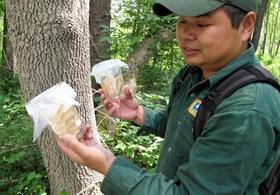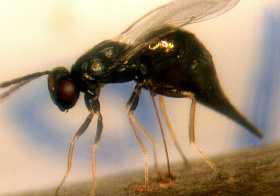The Future of Pennsylvania Forests: The Emerald Ash Borer Strikes
Pennsylvania's Trees Are Losing Their Battle With Beetles

Ken Tomajko is working in a backyard in the South Hills of Pittsburgh. He’s using one of the latest weapons in the war on the Emerald Ash Borer.
“One of the first steps is that I have my diameter of the tree,” Tomajko said. “Come over to my chart and it’s telling me I need 50 milliliters of the active product.”
Tomajko’s an arborist with Arborel Tree Service. He’s applying an insecticide known as TREE-age to some ash trees. An inspector had told the homebuyer, Steve Levine, that he and his wife might want to protect their many ash trees from the emerald ash borer. So they called in Tomajko.
“My back yard is filled with a lot of trees,” Levine said, “and it was one of the features that very much attracted us to the house, and we kind of felt that, if we were able to do so financially, we wanted to make an effort to save as many of the trees as possible.”
Arborel charges $200 to $600 dollars, depending on the size of the tree. Homeowners like Levine can’t just spray a tree on their own with TREE-age. Tomajko explains that the application involves drilling and plugging holes.
“Drilling the tree, making sure that the system is closed, making sure that the plug, when I put it in is at an angle, is it flush so that there’s no leaks to come out the side,” Tomajko said. “Then when I put this product in there we’ll hook up right into those little arbor plugs right there and then the product will go up inside the tree.”
Protecting Forests
Treating one tree takes about 15 minutes, and lasts up to three years. Many homeowners may not know their ash trees need protection. The tree Tomajko’s injecting with TREE-age looks pretty healthy to an untrained eye. But that doesn’t necessarily mean anything. The pest that’s attacking this type of tree is small. When the damage reaches the human eye level, it’s too late.
While TREE-age is useful for property owners and communities, it’s too expensive and time consuming for the thousands of trees in our native forests. In Pennsylvania, ash trees are most prominent in the northern tier. The emerald ash borer doesn’t have any natural enemies in the U.S., and our Ash trees lack any natural resistance to it.
So for forests, the only hope is a biological control.
“We just open it up, put them next to the tree, kind of urge them out a little bit. They fly away,” said Dr. Donald Eggen.

Eggen is the Forest Health Manager with the Bureau of Forestry in the Pennsylvania Department of Conservation and Natural Resources (DCNR). In a state forest in central Pennsylvania, he’s releasing tiny wasps that are aggressive enemies of the emerald ash borer (EAB) in the beetle’s native Asia.
“These are very small, tiny wasps…” Eggen said, “…These guys are specialized in attacking other insects … so these are tiny wasps that look for EAB larvae under the bark…”
Eggen said the DCNR expects the wasp program to take at least a decade before the agency knows whether it’s made a difference. Even then, the insect won’t be eradicated, just controlled to a manageable level. Eggen said the wasp program doesn’t help our existing Ash trees, only their successors.
“From the standpoint of the forests,” Eggen said, “these trees are going to die. In this forest that we’re here, virtually all of them are going to die eventually, within three to five years, if not sooner.”
Economic Impact
State agencies don’t yet know how hard the loss of ash trees will hit Pennsylvania’s economy. The emerald ash borer is close, but hasn’t quite made it to Pennsylvania’s northern forests where ash trees feed a profitable baseball bat industry.
A recent study in the journal of environmental management estimates the cost to communities nationwide will be $12.5 billion. So far, Congress has appropriated about $280 million to the USDA. The U.S. Forest Service has spent around $30 million of its own money on research and bio-controls since 2003.
Spread of the Emerald Ash Borer
The emerald ash borer was first detected in and around Detroit in 2002. It probably hitched a ride from Asia in packing materials made of wood. Since then, it has spread into 15 other states, including Pennsylvania, and seems unstoppable.
“It’s like a perfect pest for trees,” said Phillip Bell. Bell manages the Eastern Region Emerald Ash Borer Program for the USDA’s Animal and Plant Health Inspection Service.
“It's small,” Bell said. “Early infestations can go undetected for a number of years, and by the time we find the pest with the tools that are available right now, it can have spread to other locations, either just natural spread or via fire wood or logs.”
The borer was first found in Pennsylvania in 2007 in and around Cranberry Township, a fast-growing suburb north of Pittsburgh. Researchers have discovered that the insect landed in the area seven or eight years before it was detected. Since then it has spread to at least 22 other counties. The state developed a detailed Emerald Ash Borer Action Plan in 2006. A plan, yes, but, as it turned out, Bell said, not a very successful one.
“The plan as written and developed is great,” Bell said. “Would be perfect if we had a small infestation, but the fact is the infestations are more than what we thought, so it’s hard to garner the resources to address all those new infestations.”
But Pennsylvania agencies are still trying. A new action plan asks urban communities to figure out if they want to treat stricken trees individually, or replace them with other tree species. The plan also calls for foresters to reduce the percentage of ash trees they grow.
So, what have we learned from the whole emerald ash borer experience? USDA scientists say a lot. They believe their work is uncovering other insect pests that are approaching the United States, and is giving agencies impetus for closer inspections of goods coming into the country — something that could have stopped the emerald ash borer in the first place.
Other Audio
-
Cities Spend $2B on Tree Pests/Disease; Homeowners Over $1B (Download)
You may need: Adobe Flash Player.
Now Playing on EPM 90.5
Internet highlights
- Online Casinos Not On Gamstop
- Non Gamstop Casinos
- Casino Non Aams
- Casino Not On Gamstop
- Non Gamstop Casino
- UK Casinos Not On Gamstop
- Online Casinos
- Non Gamstop Casino UK
- Best Online Casino Canada
- UK Gambling Sites Not On Gamstop
- オンラインカジノ
- Non Gamstop Casino Sites UK
- Reputable Non Gamstop Casinos
- Casinos Not On Gamstop
- Best Betting Sites UK
- Casinos Online
- Casino En Ligne France
- Non Gamstop Casino Sites UK
- Non Gamstop Casino






Comments
The points Rob Gorden made are all valid. Property owners wanting to protect individual ash trees can inject them. This action is not logistically or financially possible for forested areas or all of urban ash trees lining streets of threatened cities. Parasitic wasps are being released in several states to be evaluated as a means to slow EAB spread in unprotected ash trees. Researchers stress that it will take several years to assess the impact of these wasps in control. Landowners and municipalities need to decide what ash trees are worth paying to protect, and carrying out a plan to protect them in the near term.
In all fairness, I believe it should be known that Rob Gorden is Director of National Sales for ArborJet, the firm that sells Tree-Age and equipment to inject trees. His points are correct and come from experience of his company working with many cities and certified arborists to protect ash trees.
Just a couple of comments regarding this article. Not only is the product mentioned effective against EAB, it is also used by scores of cities against this pest. It protects the tree for two years.
The article stated that costs are from $200-$600. This is a very deceptive, as most homeowners are going to pay from $8-$12 per inch of tree diameter. Which means that for a 10" diameter ash growing on your property, the cost is between $80-$120 every 2 years, or $40-$60. annualized.
Also, most cities, including Pittsburgh that are using this injection with this product, which is sealed inside the trunk of the tree (nothing in the soil, water, air), are paying considerably less, to treat hundreds, to tens of thousands of trees in this way.
While it is not practical to save the millions of forest growing ash, it is very practical to save urban public and private ash trees currently growing. In fact most studies have shown that with this product, used to protect ash for two years, you can treat an ash tree for 20-30 years before that cost is equal to the cost to remove and replace the tree.
Whether the goal is to save a valuable ash, which is now very possible, or to manage the city ash trees, to slow the pest, and slowly reduce ash populations over decades, there is now a solution that works.
One final comment regarding the new parasatoid wasps is that most scientists know that the goal with these wasps is not to stop the current march of EAB. They reproduce more slowly than EAB, are less agressive, and must have EAB already there, in order to survive. They are also more effective in rural forests than in urban landscapes due to the infrequency of ash trees.
So, the goal with wasps is long term effort to keep EAB in check, after most of the forest ash are dead. This is not the answer for your backyard ash if EAB threatens. The time to act is now, if it's been found within 15 miles of your location. It kills just about every ash it attacks, and it can hide from view for two years while eating your tree.
Just wanted to clear up some confusion……